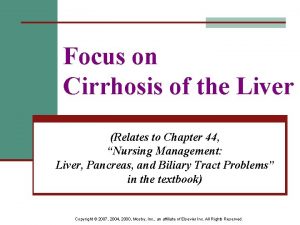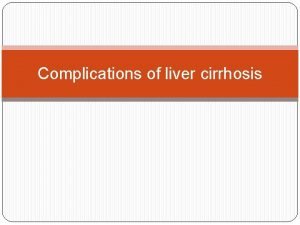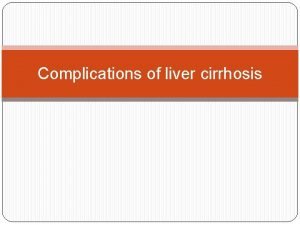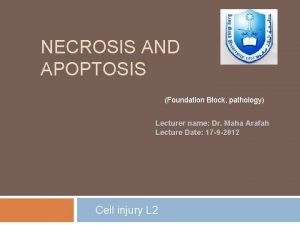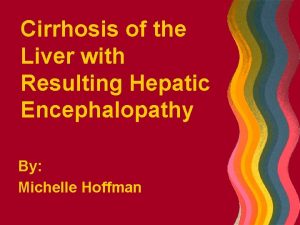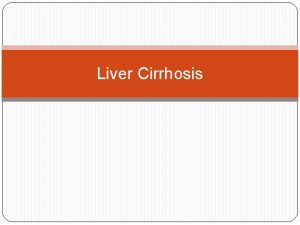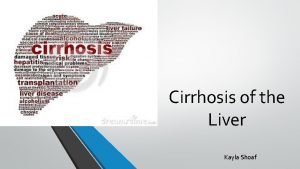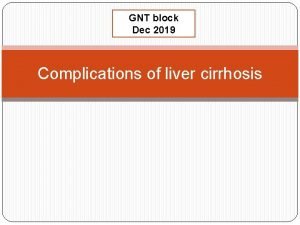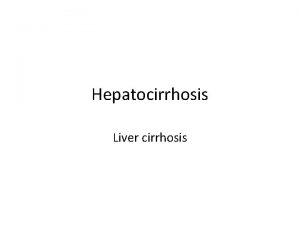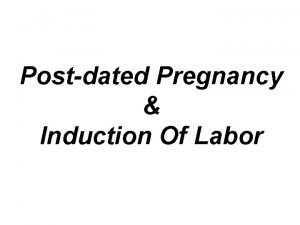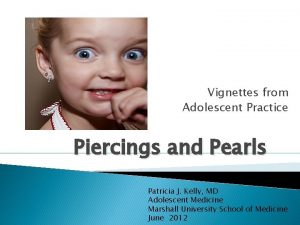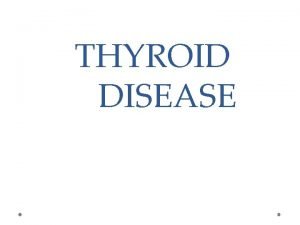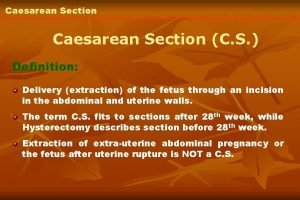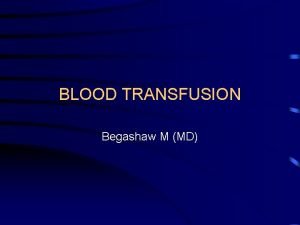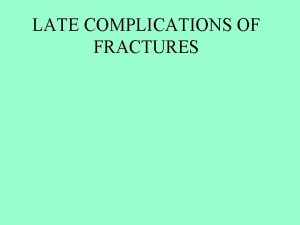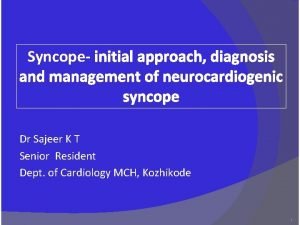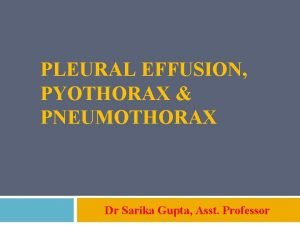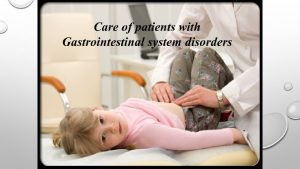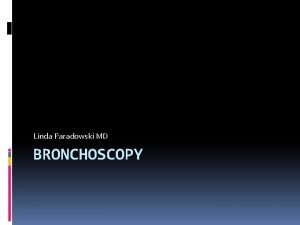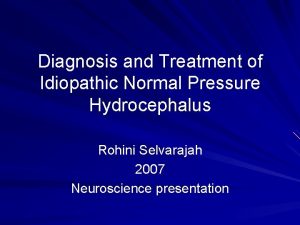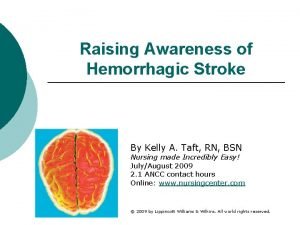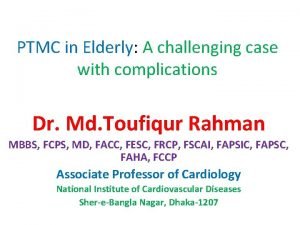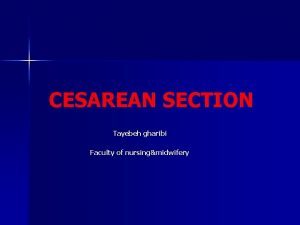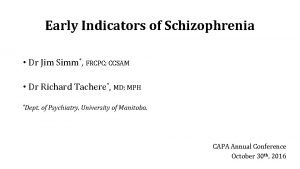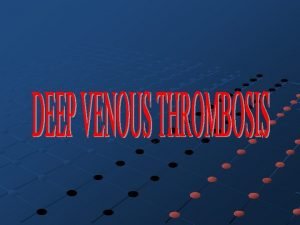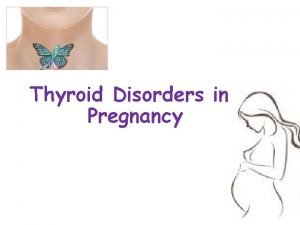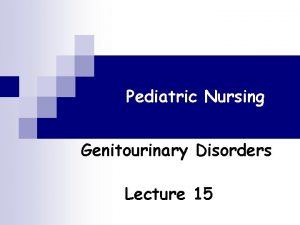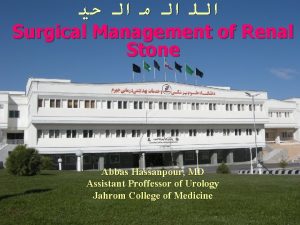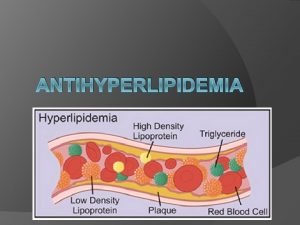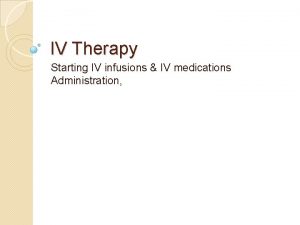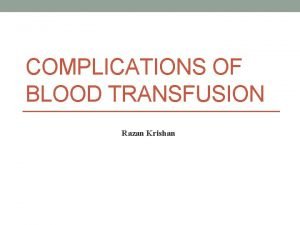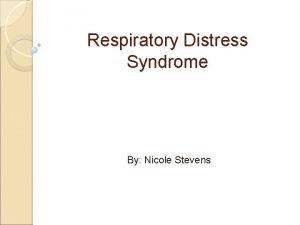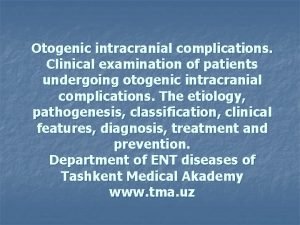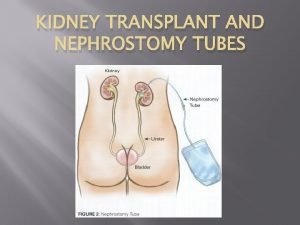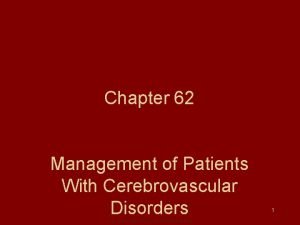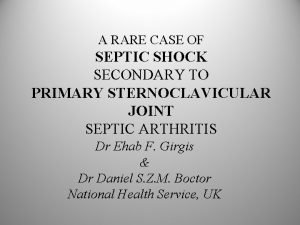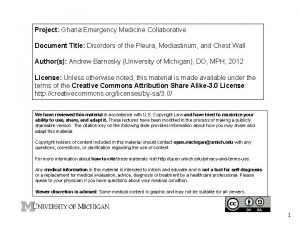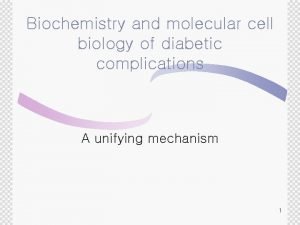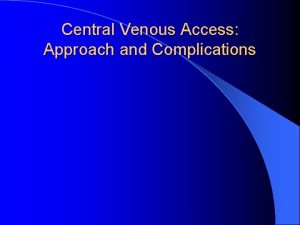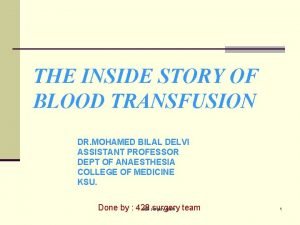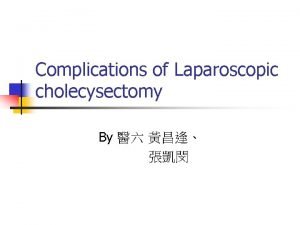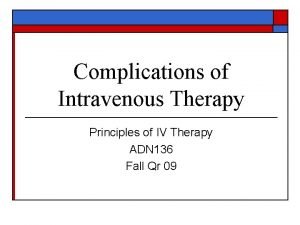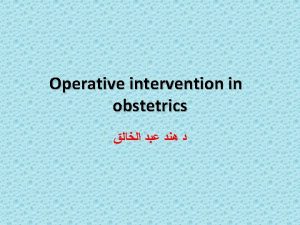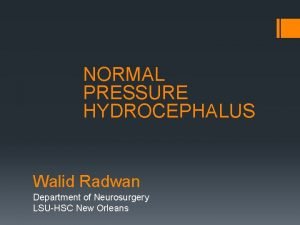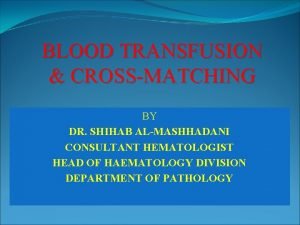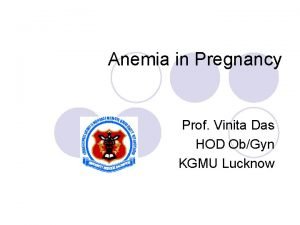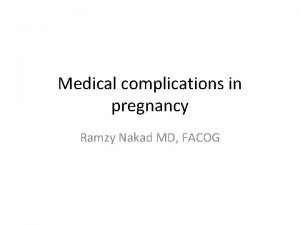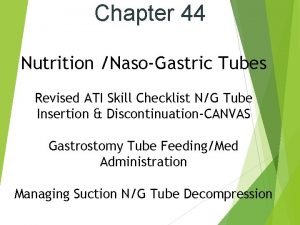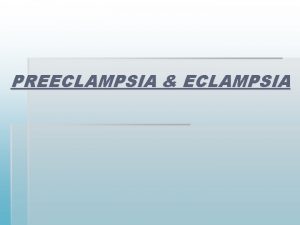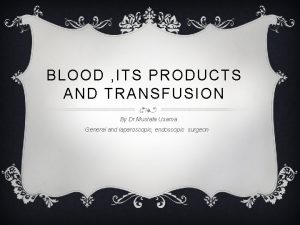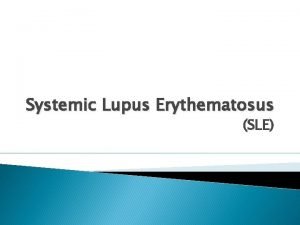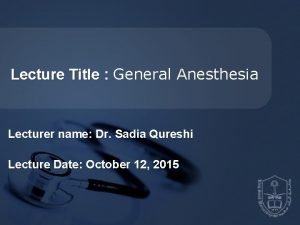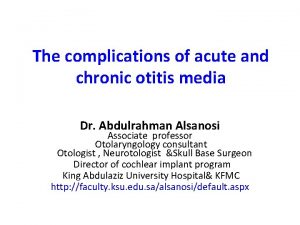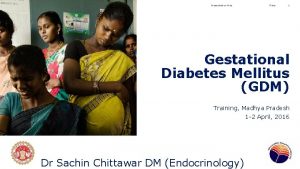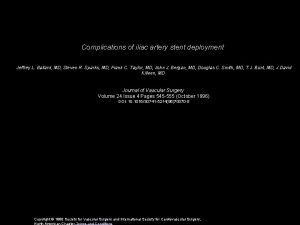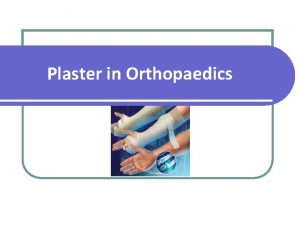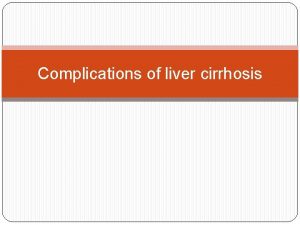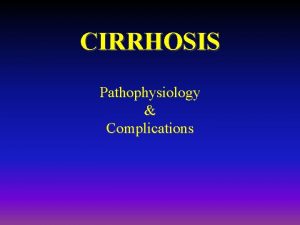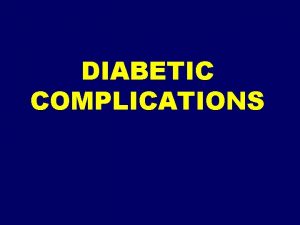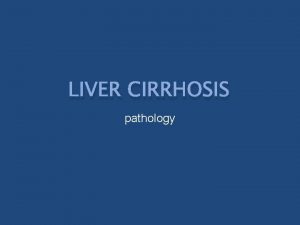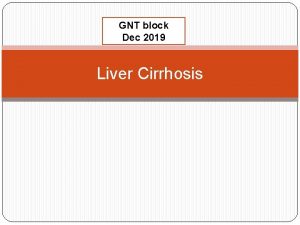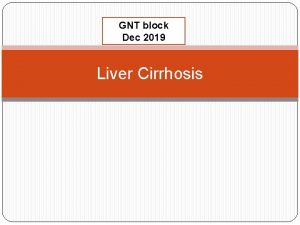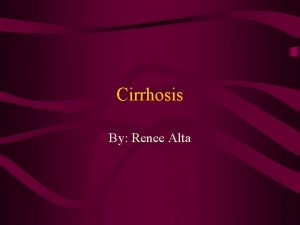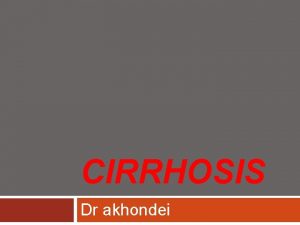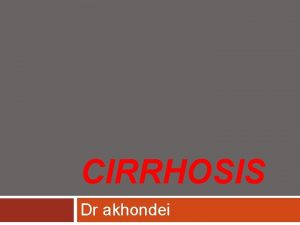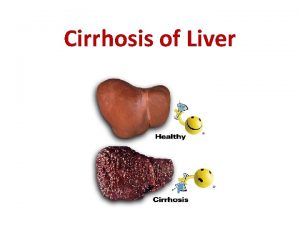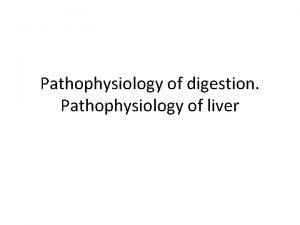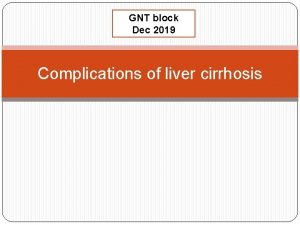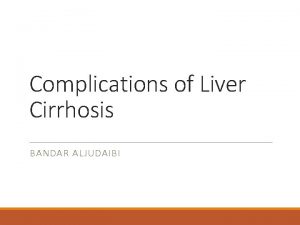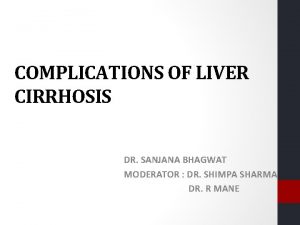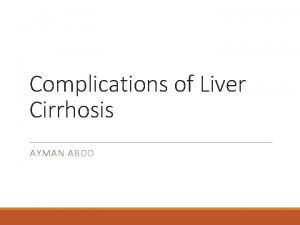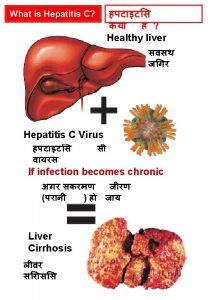CIRRHOSIS Pathophysiology Complications What is Cirrhosis LIVER CIRRHOSIS













































































- Slides: 77

CIRRHOSIS Pathophysiology & Complications

What is Cirrhosis?

LIVER CIRRHOSIS DEFINITION Cirrhosis consists of fibrosis of the hepatic parenchyma, resulting in nodule formation. It represents the consequences of a sustained wound-healing response to chronic liver injury from a variety of causes


LIVER CIRRHOSIS ETIOLOGY Alcoholism Cardiac cirrhosis Chronic viral hepatitis Inherited metabolic liver disease Hepatitis B Hemochromatosis Hepatitis C Wilson's disease Autoimmune hepatitis α 1 Antitrypsin deficiency Nonalcoholic steatohepatitis Cystic fibrosis Biliary cirrhosis Primary biliary cirrhosis Primary sclerosing cholangitis Autoimmune cholangiopathy Cryptogenic cirrhosis

Normal liver functions Carbohydrate Metabolism Hypo- or hyperglycemia Fatty Acids Metabolism Lipid Transport Hyper- or hypolipidemia Proteins Metabolism Serum Albumin Vitamin K–Dependent Blood Coagulation Proteins Bilirubin Metabolism Bile Production Fat-Soluble Vitamins Detoxification Drugs and hormones Providing continual source of energy for entire body Regulation of storage and modulate availability of systemic nutrients Subject to hormonal modulation by endocrine organs (Pancreas, adrenal gland, and thyroid, neuronal regulation)






What is pathophysiology of Cirrhosis?

Cirrhosis Causes (Etiology of chronic necrosis) + Host (Liver reaction) Lead to Cirrhosis & complications









What is clinical manifestation of Cirrhosis?

Cirrhosis Clinical manifestations: - No symptoms (routine examination) 40% - Impaired hepatocellular function (Liver failure) - Portal hypertension - Clinical manifestation of underlying disease


What is natural history of Cirrhosis?



How do you make diagnosis of cirrhosis?

Cirrhosis Diagnostic approach: 1. Liver function tests (PT, . , Alb, Bili, PLT) 2. Liver damage tests (AST>ALT, Alk. Ph) 3. Liver ultrasound (nodularity, decrease in size, portal vein enlargment, prominent left lobe) 4. Etiological diagnostic tests 5. Liver biopsy 6. Surveillance tests (AFP, sonography, endoscopy, pracentesis, creatinine)








What is general clinical management of cirrhosis?

Cirrhosis Clinical management: 1. Etiological treatment 2. Prophylactic treatment 3. Pre-transplantation care 4. Liver transplantation







































MALIGNANT TRANSFORMATION • Rapid, unexplained weight loss • Unexplained fever • Pain in the right Hypochondrium • Rapid enlargement of liver / one of the nodules • Hepatic Rub / Hepatic Bruit • Hemorrhagic ascitic fluid • Malignant cells in cytology of Ascitic fluid • Confirmation by USG / CT / AFP / Biopsy
 Pathophysiology of cirrhosis of liver
Pathophysiology of cirrhosis of liver Splenomegaly liver cirrhosis
Splenomegaly liver cirrhosis Complication of liver cirrhosis
Complication of liver cirrhosis Mitochondrial swelling
Mitochondrial swelling Liver cirrhosis stages
Liver cirrhosis stages Pes statement for liver cirrhosis
Pes statement for liver cirrhosis Defination of liver
Defination of liver Cirrhosis pathogenesis
Cirrhosis pathogenesis Pes statement for liver cirrhosis
Pes statement for liver cirrhosis Hyperestrinism cirrhosis
Hyperestrinism cirrhosis Hepatochirosis
Hepatochirosis Causes of post term pregnancy
Causes of post term pregnancy Dd of meningitis
Dd of meningitis Local complications
Local complications Septic arthritis complications
Septic arthritis complications Hypothyroidism complications
Hypothyroidism complications C section complications
C section complications Complications of blood transfusion
Complications of blood transfusion Late complications of fracture
Late complications of fracture Heart failure complications
Heart failure complications Carotid sinus hypersensitivity
Carotid sinus hypersensitivity Lights criteria
Lights criteria Contraindications of colostomy irrigation
Contraindications of colostomy irrigation Bronchoscopy complications
Bronchoscopy complications Complications of hydrocephalus
Complications of hydrocephalus Who stroke definition
Who stroke definition Berotec nebs
Berotec nebs Ptmc complications
Ptmc complications Calcium infusion protocol
Calcium infusion protocol Csection layers
Csection layers Jim simm
Jim simm Dvt complications
Dvt complications Hypothyroidism pregnancy
Hypothyroidism pregnancy The events and complications begin to resolve themselves
The events and complications begin to resolve themselves Post dated pregnancy complications
Post dated pregnancy complications Complications of shigellosis
Complications of shigellosis Glomerulonephritis complications
Glomerulonephritis complications Eswl complications
Eswl complications Early and late complications of blood transfusion
Early and late complications of blood transfusion Hyperlipidemia complications
Hyperlipidemia complications Iv site complications
Iv site complications Early and late complications of blood transfusion
Early and late complications of blood transfusion Complications of respiratory failure
Complications of respiratory failure Adhesive arachnoiditis
Adhesive arachnoiditis Gastrostomie complications
Gastrostomie complications Nephrostomy tube complications
Nephrostomy tube complications Nursing management of stroke
Nursing management of stroke Septic arthritis complications
Septic arthritis complications Light criteria
Light criteria What is the definition of a short story
What is the definition of a short story Molecular cell biology of diabetic complications
Molecular cell biology of diabetic complications Lumbar puncture tray articles
Lumbar puncture tray articles Most common complication of central venous catheter
Most common complication of central venous catheter When to transfuse blood
When to transfuse blood Abdominal insufflation complications
Abdominal insufflation complications Iv infiltration vs phlebitis
Iv infiltration vs phlebitis Episiotomy types
Episiotomy types Complications c section
Complications c section Fenestrated tracheostomy
Fenestrated tracheostomy Walid radwan
Walid radwan Complications of insulin resistance
Complications of insulin resistance What are the complications of blood transfusion
What are the complications of blood transfusion Complications of anemia
Complications of anemia Hypothyroidism tsh levels
Hypothyroidism tsh levels Enteral tube feeding ati
Enteral tube feeding ati How to mix shingrix vaccine
How to mix shingrix vaccine Kesselbachs plexus
Kesselbachs plexus External fixation tibia
External fixation tibia Complications of eclampsia
Complications of eclampsia What are the complications of blood transfusion
What are the complications of blood transfusion Veptr complications
Veptr complications Complications of lupus
Complications of lupus Anesthesia complications
Anesthesia complications Caesarean section slideshare
Caesarean section slideshare Otitis media complications
Otitis media complications Gestational diabetes complications
Gestational diabetes complications Iliac stent complications
Iliac stent complications Principles of plaster of paris
Principles of plaster of paris
